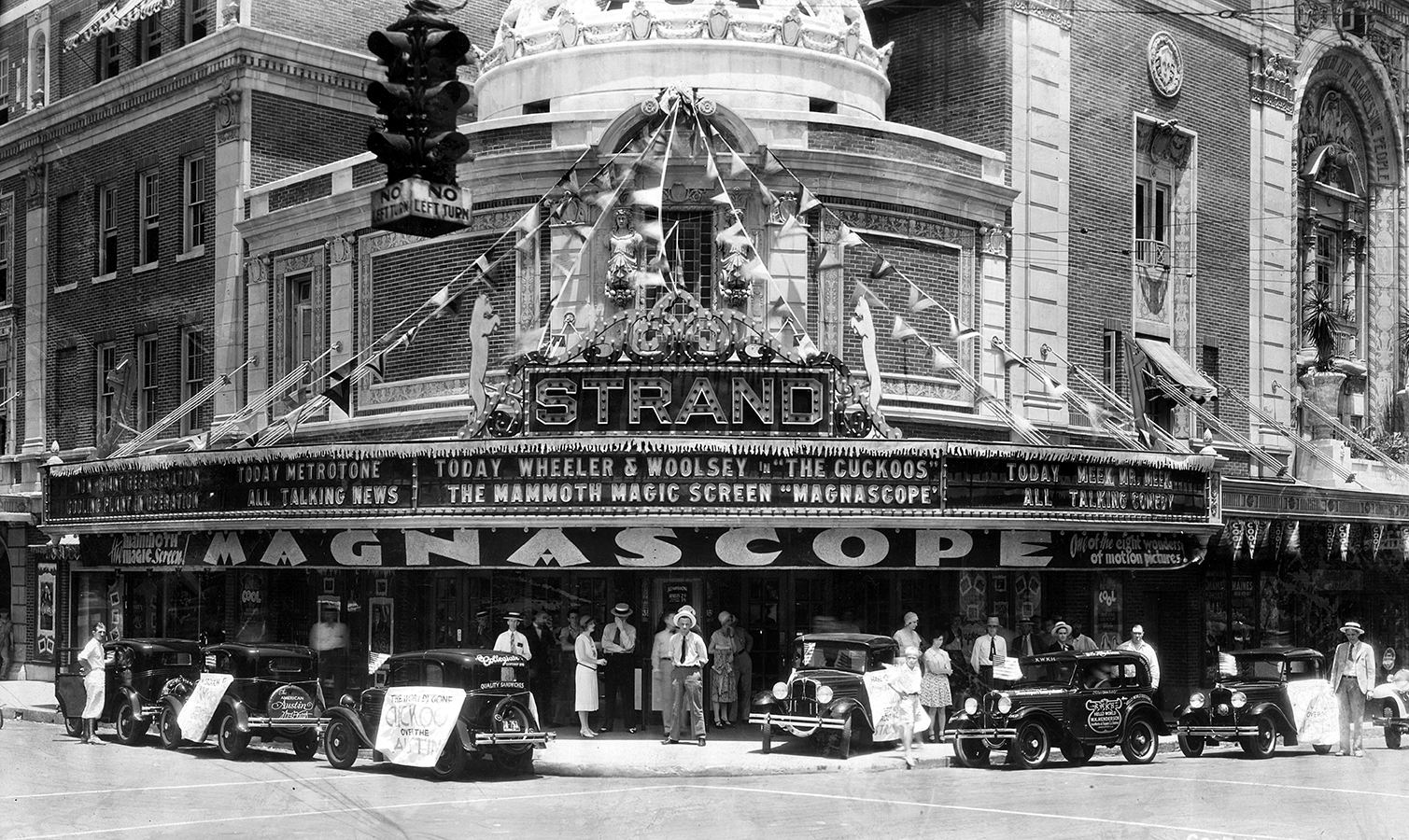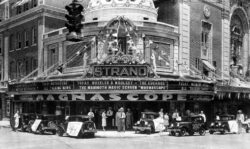Strand Theatre
Designed by New Orleans–based architect Emile Weil, the Strand Theatre opened in Shreveport on July 3, 1925.

Louisiana State University Shreveport, Noel Memorial Library
Exterior view of Shreveport's Strand Theatre ca. 1930. Grabill Photographers.
The Strand Theatre, located at the corner of Crockett Street and Louisiana Avenue in downtown Shreveport, opened July 3, 1925. Its first production was a two-night engagement of The Chocolate Soldier, performed by Fortune Gallo’s traveling San Carlo Opera Company. Promoted as the “Million-Dollar Theatre,” the air-conditioned, 2,250-seat Strand was built by Abraham and Julian Saenger, a pair of pharmacist-turned-Vaudeville mogul brothers who were the sons of Shreveport rabbi Israel Saenger of B’nai Zion Temple. The Shreveport natives, who had been active members of the local business community since 1894, relocated their business headquarters to New Orleans around 1917. Throughout the 1920s they built theatres in Texas, Louisiana, Arkansas, Florida, and Mississippi. To build and manage the Strand, the Saengers formed a new company, Saenger-Ehrlich Enterprises, Inc., with brothers Harry and Simon Ehrlich of Texarkana, Texas. The company hired architect Emile Weil of New Orleans to design a Vaudeville palace for Shreveport that was larger and more opulent than any other in the Saenger empire.
Weil designed other significant theaters for the Saengers around the same time as the Strand, including the Saenger Theatre in New Orleans, which opened in 1927, and the Perot Theatre in Texarkana, which opened in 1924. His opulent designs for the Strand borrowed elements from various architectural styles, including a Baroque exterior dome, Gothic arches, and Corinthian columns. The 16,500 square-foot, four-story building’s lavish details include a gilded-marble grand staircase, a fourteen-foot-tall, one-ton crystal chandelier, and a rare, 939-pipe Robert Morton “Golden Voice” pipe organ. Other impressive details included an eighty-one-foot-wide stage flanked by gold-leafed columns, elaborate ceilings designed to replicate Venice’s Palazzo Ducale, and a mirror-lined gentlemen’s smoking lounge, which was located underneath the main foyer and accessed via an underground tunnel. The Times-Picayune described the production of draperies for the Strand by New Orleans’s Maison Blanche department store as an undertaking requiring “1,100 yards of velour and satin, and four weeks of work by 13 hand-sewers.”
The 1920s were a time of rapid cultural change, and motion pictures quickly supplanted vaudeville following the introduction of synchronized sound. In 1929 the Saengers sold all their theater holdings to Paramount Publix, which operated the Strand as a single-screen movie theater until 1970. The theatre hosted Academy Award–winning director John Ford’s premiere of his 1960 film The Horse Soldiers, which was partially shot on location in Alexandria, Natchitoches, and Shreveport, with stars John Wayne and William Holden in attendance. By the mid-seventies, however, the theater was screening low-budget films to dwindling crowds and needed repairs. Shortly after shuttering the Strand in 1977, ABC-Interstate Theatres, Inc. donated the building to a local nonprofit group established to preserve it.
After successfully applying to add the Strand to the National Register of Historic Places in 1977, the board of directors of the Strand Theatre Corporation of Shreveport embarked upon a seven-year, $4.3 million fundraising campaign to restore the building to its original grandeur. Shreveport attorney S. Judd Tooke, who drafted the Strand’s nomination for the National Register, wrote that it was “one of the few, largely unaltered, remaining examples of the grandiose movie-vaudeville theaters built in the 1920s.” The Strand reopened on December 21, 1984, and has operated as a nonprofit venue for touring Broadway musicals ever since. The Strand was officially named the Official State Theatre of Louisiana by Gov. Edwin Edwards in 1980.
